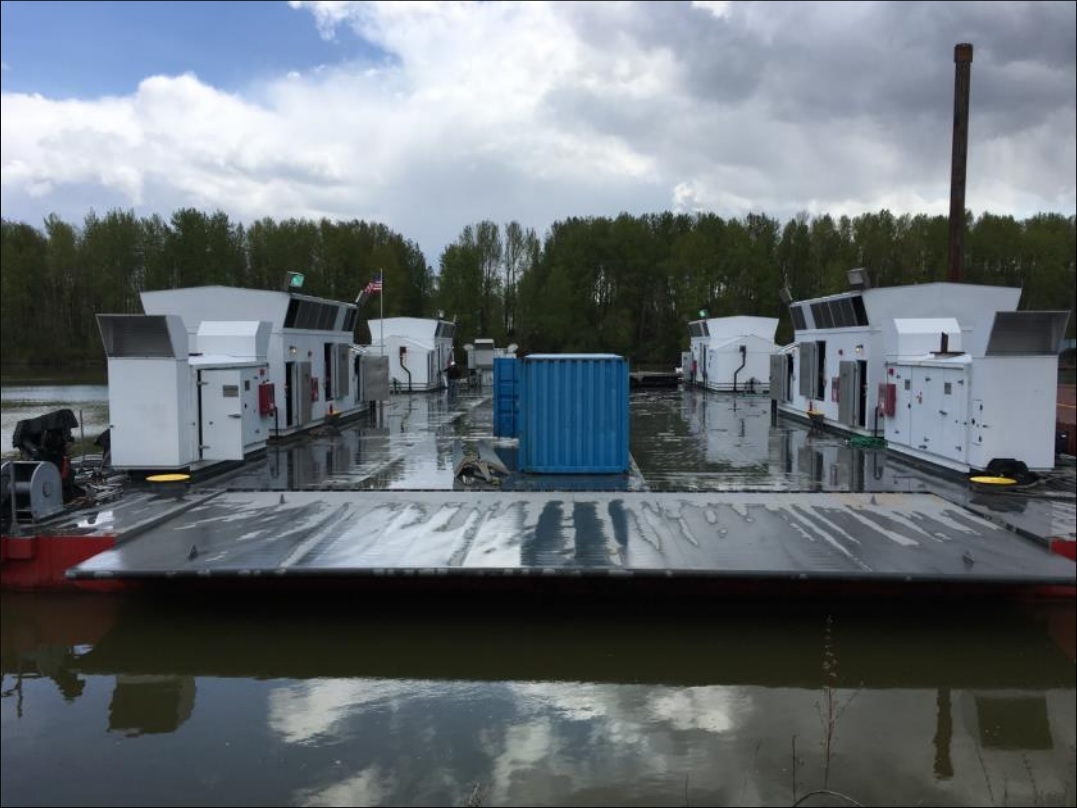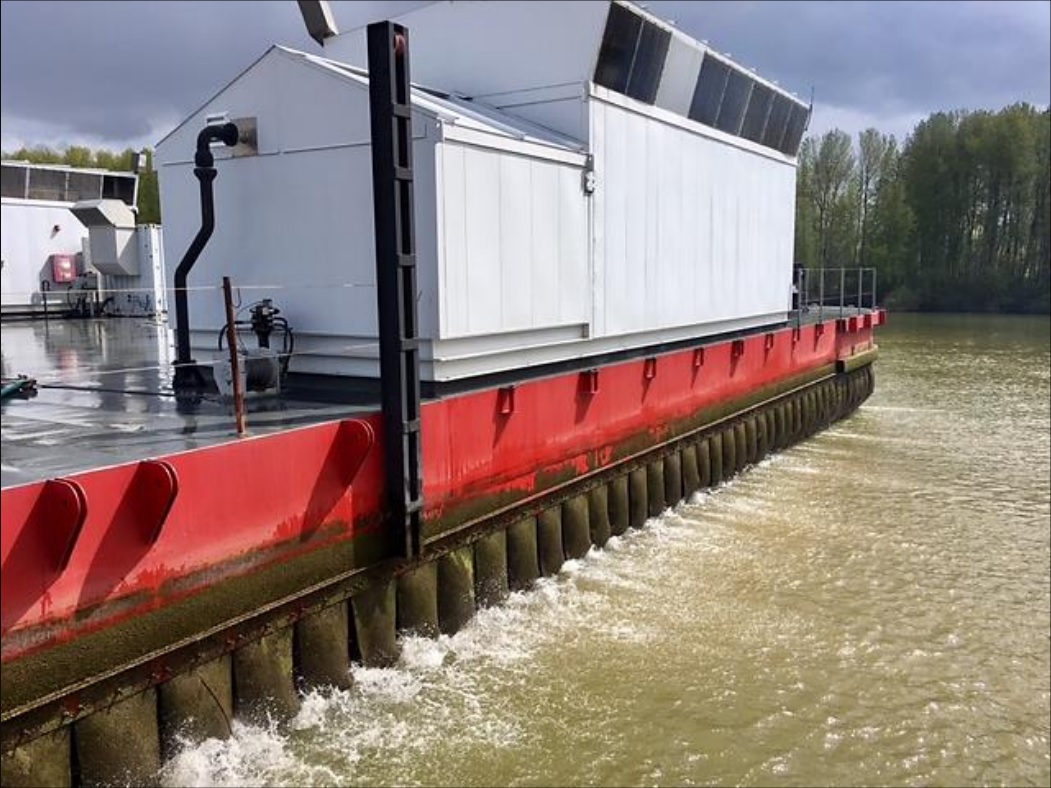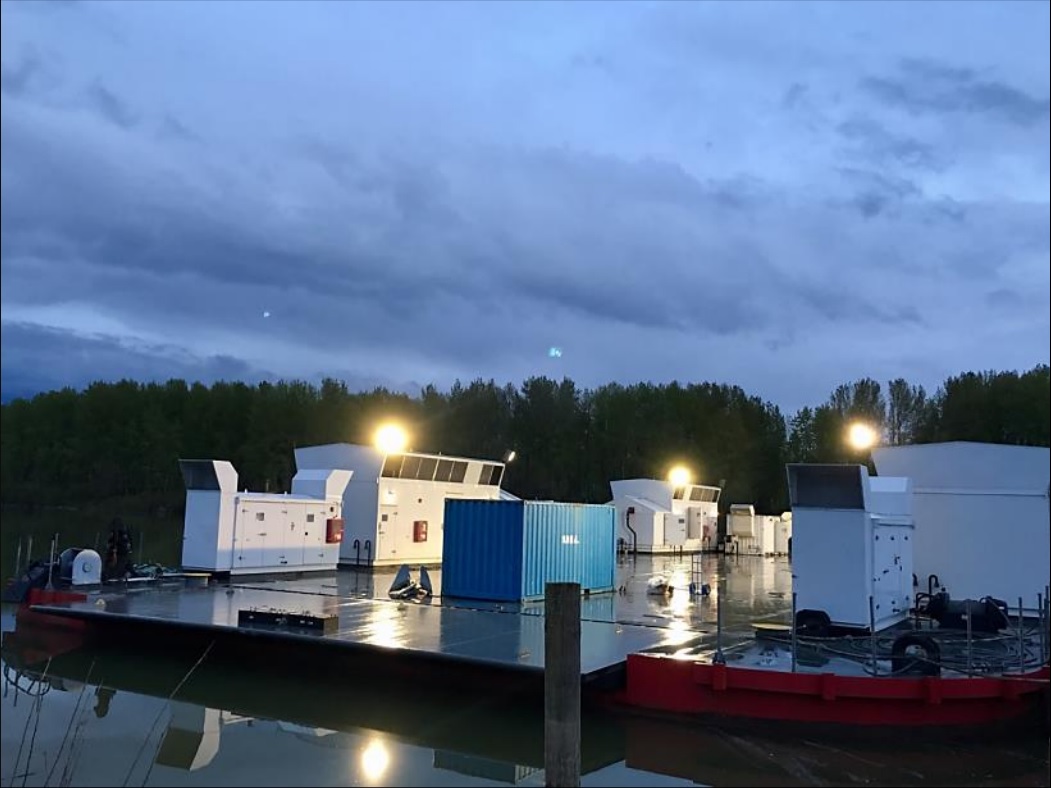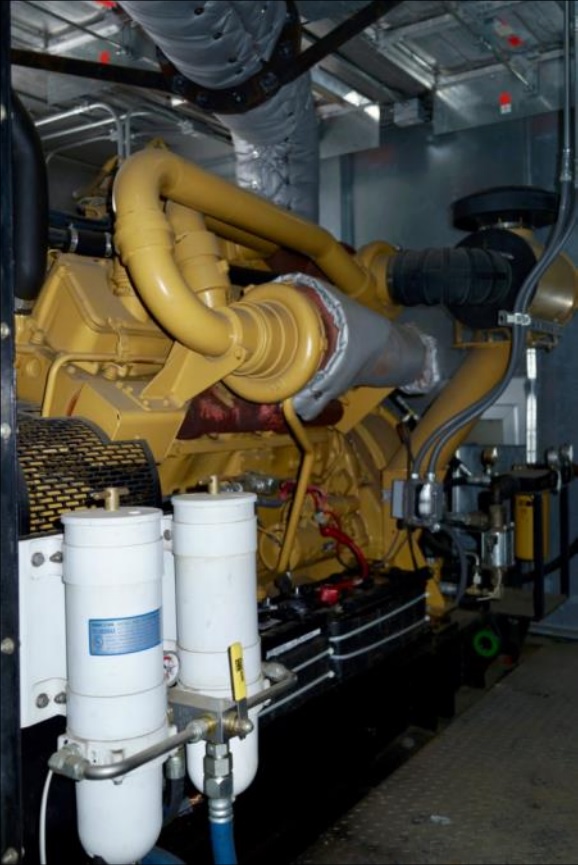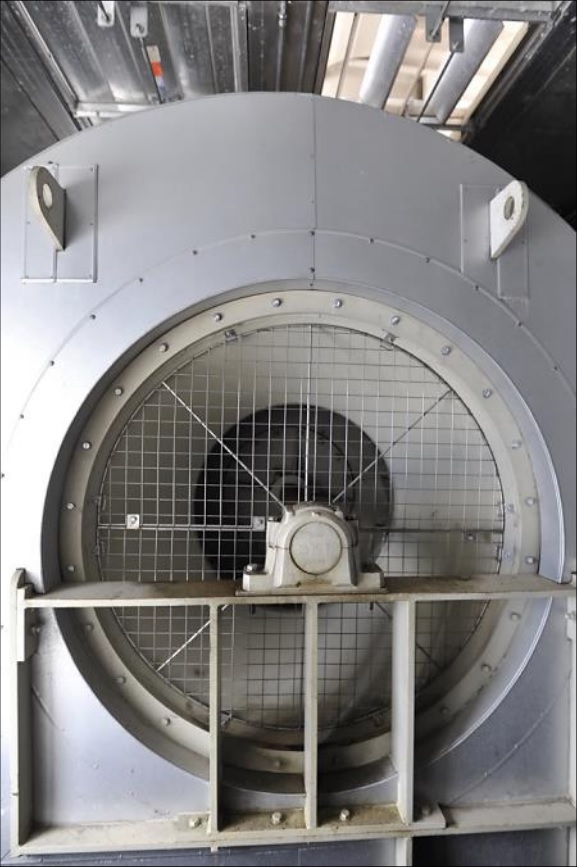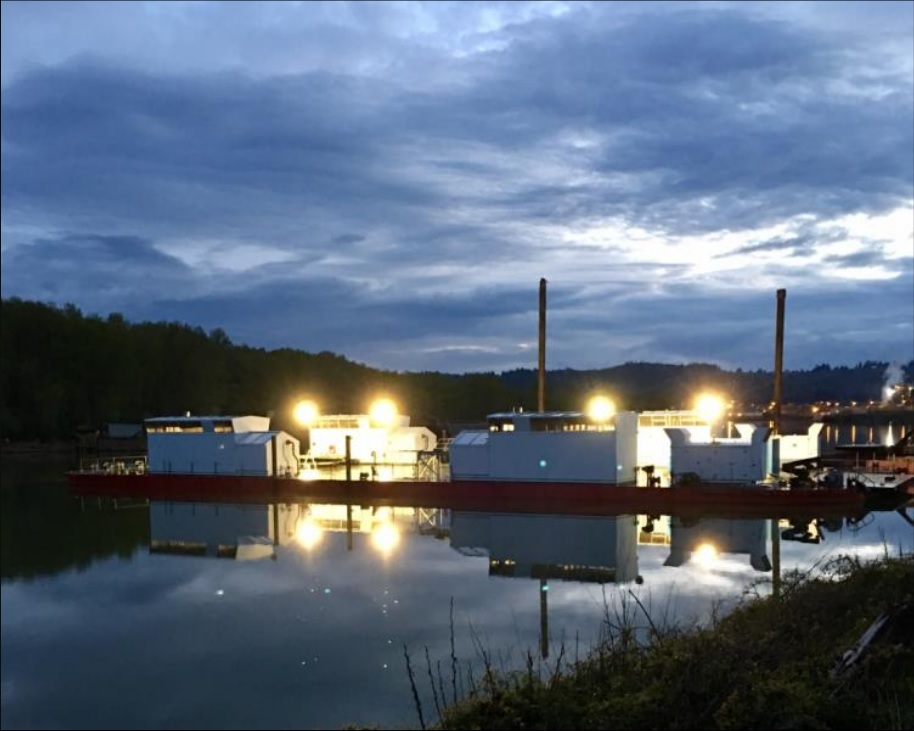Lift-Off: World's Largest Hover Barge is "Ready-To-Work"
Press Release PDF File: Lift-Off: World's Largest Hover Barge is "Ready-To-Work"![]()
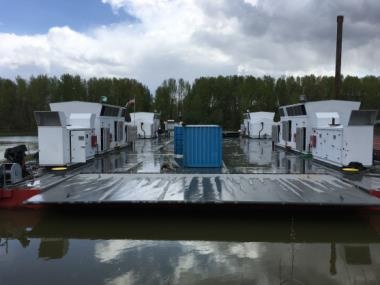 Hover barges are generally found in Star Wars movies, science fiction novels by David Brin and virtual reality video games as they transport people and cargo down strange streets or unload hordes of furry aliens firing blasts from energy weapons in Wild West-style gunfights. In April 2017 though, after commissioning, passing hovering trials and a champagne christening, the real-world's largest hover barge "Ghost" with its 9,000 Sq. ft. clear deck and 450 tonne payload capacity is now ready-to-work.
Hover barges are generally found in Star Wars movies, science fiction novels by David Brin and virtual reality video games as they transport people and cargo down strange streets or unload hordes of furry aliens firing blasts from energy weapons in Wild West-style gunfights. In April 2017 though, after commissioning, passing hovering trials and a champagne christening, the real-world's largest hover barge "Ghost" with its 9,000 Sq. ft. clear deck and 450 tonne payload capacity is now ready-to-work.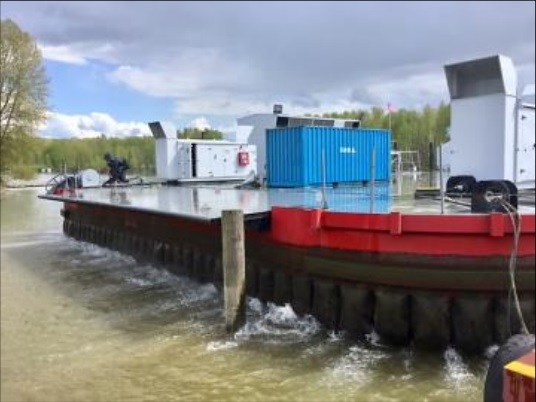 For over fifty years, specialized hover barges have proven to be cost-effective solutions for transport of heavy loads over environmentally challenging and sensitive terrains where it was not feasible to build roads and bridges. Hover barges also supported construction, coring and drilling operations on beaches, tidal mud flats, marshland and inland seas. These versatile craft were designed and built to perform in swamps, wetlands, tundra, ice, desert and shallow water - basically anywhere wheeled or tracked vehicles and conventional barges are unable to work - as their work history demonstrates.
For over fifty years, specialized hover barges have proven to be cost-effective solutions for transport of heavy loads over environmentally challenging and sensitive terrains where it was not feasible to build roads and bridges. Hover barges also supported construction, coring and drilling operations on beaches, tidal mud flats, marshland and inland seas. These versatile craft were designed and built to perform in swamps, wetlands, tundra, ice, desert and shallow water - basically anywhere wheeled or tracked vehicles and conventional barges are unable to work - as their work history demonstrates.
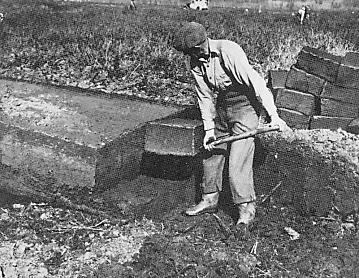 One early hover barge helped Sun Gro become what is today the largest producer and distributor of peat moss in North America. Peat mining in Burns Bog on Lulu Island in the Fraser River near Vancouver, British Colombia started in 1929. Mined peat was used for agricultural purposes, as a fuel to heat homes and even in weapons production. Workers would clear vegetation from the top of the peat, then use sharpened, square-edged spades to cut blocks of peat. These were stacked to dry in the wind and sun for up to a year before being loaded onto horse-drawn wagons (later tractor-drawn, then a wire mesh conveyor system, then narrow-gauge railroad) for the trip to the processing plant. During World War II, the U.S. Government purchased peat from Burns Bog to use as packing material for bombs. More than 100,000 bales of local peat were shipped to a magnesium production plant near Las Vegas. Procurement of peat was so vital to the war effort that the U.S. government considered purchasing 200 acres of the bog. Until post-World War II, harvesting in Burns Bog was purely physical, back- breaking labor.
One early hover barge helped Sun Gro become what is today the largest producer and distributor of peat moss in North America. Peat mining in Burns Bog on Lulu Island in the Fraser River near Vancouver, British Colombia started in 1929. Mined peat was used for agricultural purposes, as a fuel to heat homes and even in weapons production. Workers would clear vegetation from the top of the peat, then use sharpened, square-edged spades to cut blocks of peat. These were stacked to dry in the wind and sun for up to a year before being loaded onto horse-drawn wagons (later tractor-drawn, then a wire mesh conveyor system, then narrow-gauge railroad) for the trip to the processing plant. During World War II, the U.S. Government purchased peat from Burns Bog to use as packing material for bombs. More than 100,000 bales of local peat were shipped to a magnesium production plant near Las Vegas. Procurement of peat was so vital to the war effort that the U.S. government considered purchasing 200 acres of the bog. Until post-World War II, harvesting in Burns Bog was purely physical, back- breaking labor. 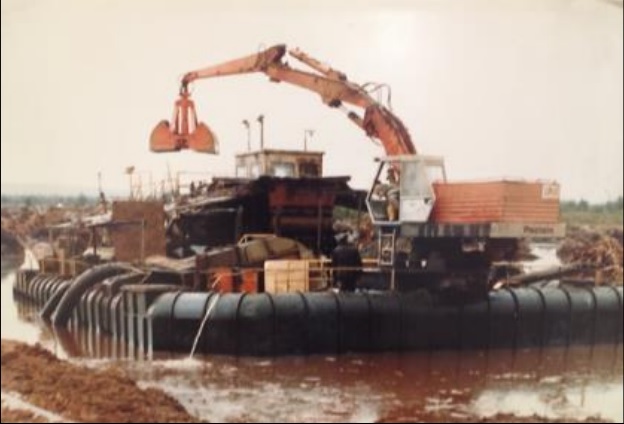 During the peak war years, Western Peat, which later became Sun Gro, had 1,600 employees. A newspaper of the day reported that the local peat industry was a higher priority than shipyards, aircraft factories, or the shipping of spruce for airplanes. Since Western Peat was unable to drain the Fraser River, a traditional method of harvesting peat bogs, the owners of Western Peat, two of whom were hands-on engineers, built a "hovering barge" in the early - mid 1970s using two military surplus Allison V12 aircraft engines powering large fans, plus a small Deutz diesel providing hydraulic and electrical power. On the front end, a large Poclain clamshell excavator would grab onto part of the soggy bog to pull itself forward. If that didn't work, the hover craft operators used large military surplus, tracked vehicles with a flatbed to winch the barge forward against the bog to dig. This "hovering barge" successfully worked from the mid-70s until 1984 when the harvesting shut down. Its remains can still be seen today abandoned in Burns Bog.
During the peak war years, Western Peat, which later became Sun Gro, had 1,600 employees. A newspaper of the day reported that the local peat industry was a higher priority than shipyards, aircraft factories, or the shipping of spruce for airplanes. Since Western Peat was unable to drain the Fraser River, a traditional method of harvesting peat bogs, the owners of Western Peat, two of whom were hands-on engineers, built a "hovering barge" in the early - mid 1970s using two military surplus Allison V12 aircraft engines powering large fans, plus a small Deutz diesel providing hydraulic and electrical power. On the front end, a large Poclain clamshell excavator would grab onto part of the soggy bog to pull itself forward. If that didn't work, the hover craft operators used large military surplus, tracked vehicles with a flatbed to winch the barge forward against the bog to dig. This "hovering barge" successfully worked from the mid-70s until 1984 when the harvesting shut down. Its remains can still be seen today abandoned in Burns Bog.
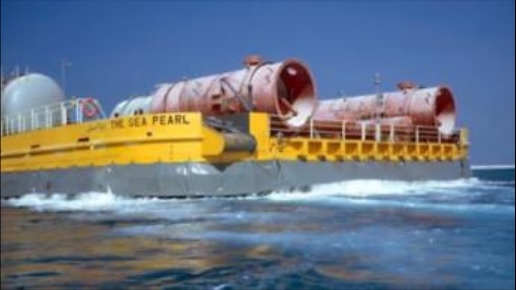 On the other side of the world, the 250 tonne payload "Sea Pearl", designed by Mackace Ltd. (Mackley Air Cushion Equipment) in the U.K., was at that time the largest hover barge in the world. Built in the mid-70s near the Mina Zayed (Zayed Port), Abu Dhabi's oldest commercial port to meet Lloyds regulations, the barge was capable of handling 2 - 3m wave heights at sea. "Sea Pearl" became the workhorse that facilitated the United Arab Emirates' expansion of their offshore oil and gas operations on Das Island, located half way between Abu Dhabi and Qatar in the Arabian Gulf.
On the other side of the world, the 250 tonne payload "Sea Pearl", designed by Mackace Ltd. (Mackley Air Cushion Equipment) in the U.K., was at that time the largest hover barge in the world. Built in the mid-70s near the Mina Zayed (Zayed Port), Abu Dhabi's oldest commercial port to meet Lloyds regulations, the barge was capable of handling 2 - 3m wave heights at sea. "Sea Pearl" became the workhorse that facilitated the United Arab Emirates' expansion of their offshore oil and gas operations on Das Island, located half way between Abu Dhabi and Qatar in the Arabian Gulf. 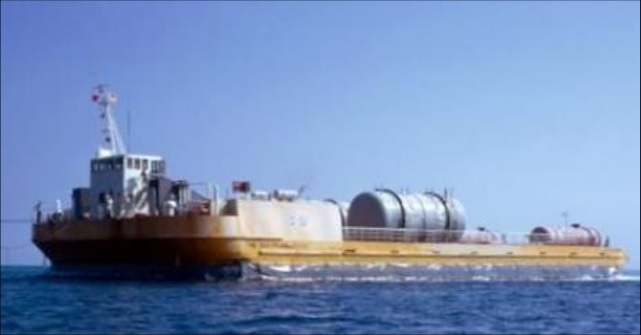 Initial plans were to construct temporary port facilities to handle transport of the prefabricated modules for the new gas liquefaction plant, but this was dropped in favor of a hover barge. Prefabricated gas plant modules were built in Abu Dhabi's port area and successfully transported floating on a 1.2m (4') cushion of air at sea over 166km, towed first by tugs and then once ashore maneuvered by a fleet of bulldozers.
Initial plans were to construct temporary port facilities to handle transport of the prefabricated modules for the new gas liquefaction plant, but this was dropped in favor of a hover barge. Prefabricated gas plant modules were built in Abu Dhabi's port area and successfully transported floating on a 1.2m (4') cushion of air at sea over 166km, towed first by tugs and then once ashore maneuvered by a fleet of bulldozers.
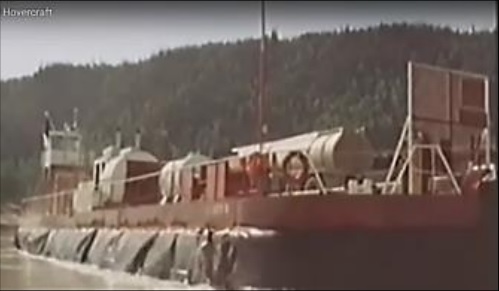 Shortly thereafter, the two close sister barges "Yukon Princess I" and "Yukon Princess II" made their mark during construction of the 800-mile (1,287km) pipeline for Alyeska Pipeline Service Co. from Prudhoe Bay to the ice-free port of Valdez. At the time, this project was one of the largest pipeline systems and at US$ 8 billion in 1977, the largest privately funded construction project in the world. The route though was nearly bisected by the Yukon River which, before the hover barges were built, could only be crossed by vehicles when it froze-over with ice thick enough to support the loads. An ice bridge was the only link to the northern world beyond the river and it was not possible to cross the country with vehicles of any kind until the lakes, rivers, bogs, swamps and tundra froze solid, which was usually in late November. Larger bodies of water, such as the mile-wide Yukon River, were not safe to cross, especially with the needed 52-ton loads of double-jointed, 48" diameter pipe on tractor-trailer rigs until late December or early January.
Shortly thereafter, the two close sister barges "Yukon Princess I" and "Yukon Princess II" made their mark during construction of the 800-mile (1,287km) pipeline for Alyeska Pipeline Service Co. from Prudhoe Bay to the ice-free port of Valdez. At the time, this project was one of the largest pipeline systems and at US$ 8 billion in 1977, the largest privately funded construction project in the world. The route though was nearly bisected by the Yukon River which, before the hover barges were built, could only be crossed by vehicles when it froze-over with ice thick enough to support the loads. An ice bridge was the only link to the northern world beyond the river and it was not possible to cross the country with vehicles of any kind until the lakes, rivers, bogs, swamps and tundra froze solid, which was usually in late November. Larger bodies of water, such as the mile-wide Yukon River, were not safe to cross, especially with the needed 52-ton loads of double-jointed, 48" diameter pipe on tractor-trailer rigs until late December or early January. 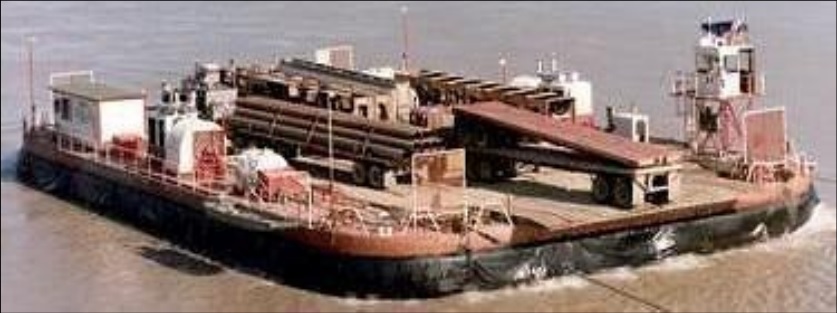 With the road and bridge running behind schedule, the river either frozen or flowing fast and furious, depending on the season, Alyeska was forced to come up with the unique two hover barge ferry system.
With the road and bridge running behind schedule, the river either frozen or flowing fast and furious, depending on the season, Alyeska was forced to come up with the unique two hover barge ferry system. 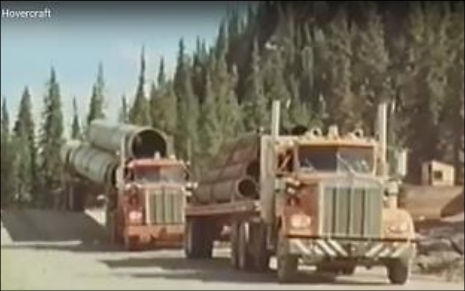 Two cable-driven ferries powered by large shoreside winches carried three trucks at a time loaded with pipe and supplies for the northern Prudhoe Bay side of the pipeline. Unlike a regular inland river barge, the hover barge was able to cross water, slush and ice so the barges were capable of operating 24/7 year round. The barges were prefabricated by Mackace in Fairbanks, Alaska and transported to the Yukon River where they were assembled on site at the River bank in sub-zero temperatures. "They didn't know it couldn't be done" was the motto adopted by Alyeska's first employees and these two hover barges helped get it done. During a five month period in 1975, the two barges carried over 634,900 tonnes of cargo across the river. Although designed for a nominal 145 tonnes payload, overload situations were common. The largest single reported load was 234 tonnes.
Two cable-driven ferries powered by large shoreside winches carried three trucks at a time loaded with pipe and supplies for the northern Prudhoe Bay side of the pipeline. Unlike a regular inland river barge, the hover barge was able to cross water, slush and ice so the barges were capable of operating 24/7 year round. The barges were prefabricated by Mackace in Fairbanks, Alaska and transported to the Yukon River where they were assembled on site at the River bank in sub-zero temperatures. "They didn't know it couldn't be done" was the motto adopted by Alyeska's first employees and these two hover barges helped get it done. During a five month period in 1975, the two barges carried over 634,900 tonnes of cargo across the river. Although designed for a nominal 145 tonnes payload, overload situations were common. The largest single reported load was 234 tonnes.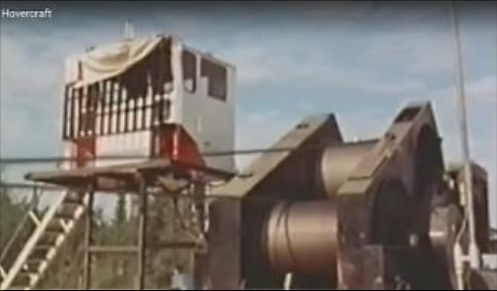 In all, the barges traveled nearly 7,000 miles over two seasons, according to one report, saving the pipeline builders more than a billion dollars while substantially speeding up pipeline construction until the 2,295' long x 30' wide (700m x 9.1m), $30 million Yukon River Bridge could be put in use.
In all, the barges traveled nearly 7,000 miles over two seasons, according to one report, saving the pipeline builders more than a billion dollars while substantially speeding up pipeline construction until the 2,295' long x 30' wide (700m x 9.1m), $30 million Yukon River Bridge could be put in use.
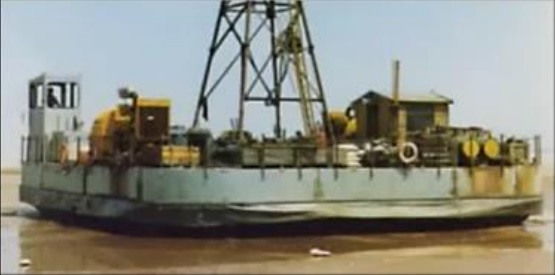 Hover barges have also been used for drilling and coring operations in remote and difficult corners of the globe from Scottish marshes to swamps in Suriname and even the Dead Sea. In 1979, a 50 tonne payload modular hover barge was trucked to the shallow water salt domes in the Dead Sea to take core samples during a geological survey of the region. Once there, the barge was towed by a Rolligon soft tire tractor to each new daily drilling site where it sat on the hot, liquid, quick sands without sinking or sticking until time to move on to the next coring site. This experience definitely proved to be of value. In 2006, Hovertrans, Inc. (formed by original managers of Makace) provided Althev Oilfield Services Ltd. the 330 ton payload, 170' x 90' drilling barge "Toucan I" with a 10' x 40' keyway drilling slot to operate in the remote swamps of Surinam on the northeastern coast of South America. "Toucan I" was powered by four powerful diesel engines providing a hover height of 4' which allowed the barge to move away from the well head once drilling was completed.
Hover barges have also been used for drilling and coring operations in remote and difficult corners of the globe from Scottish marshes to swamps in Suriname and even the Dead Sea. In 1979, a 50 tonne payload modular hover barge was trucked to the shallow water salt domes in the Dead Sea to take core samples during a geological survey of the region. Once there, the barge was towed by a Rolligon soft tire tractor to each new daily drilling site where it sat on the hot, liquid, quick sands without sinking or sticking until time to move on to the next coring site. This experience definitely proved to be of value. In 2006, Hovertrans, Inc. (formed by original managers of Makace) provided Althev Oilfield Services Ltd. the 330 ton payload, 170' x 90' drilling barge "Toucan I" with a 10' x 40' keyway drilling slot to operate in the remote swamps of Surinam on the northeastern coast of South America. "Toucan I" was powered by four powerful diesel engines providing a hover height of 4' which allowed the barge to move away from the well head once drilling was completed.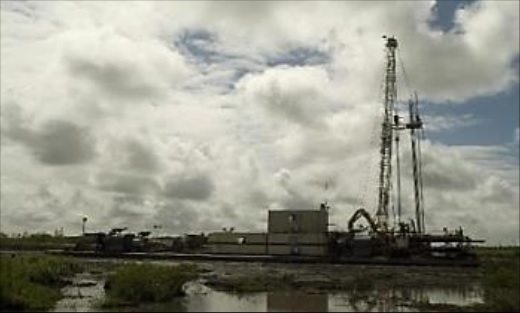 Later the oilfield company followed this up with the "Toucan II" using modular steel Flexifloats to build a 140' x 110' unit with a 300 ton payload powered by two diesel engines. There are even reports of hover barges in use in the Siberian Arctic with 181 tonne payloads in regular service and old photographs have been published showing a Soviet oil rig mounted on an air cushion platform.
Later the oilfield company followed this up with the "Toucan II" using modular steel Flexifloats to build a 140' x 110' unit with a 300 ton payload powered by two diesel engines. There are even reports of hover barges in use in the Siberian Arctic with 181 tonne payloads in regular service and old photographs have been published showing a Soviet oil rig mounted on an air cushion platform.
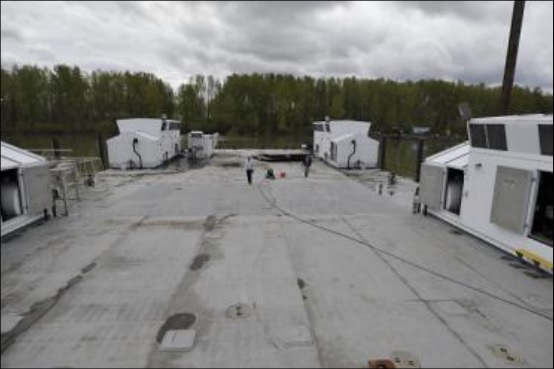 The world's largest hover barge, now named "Ghost", while it looks like a conventional barge while laying alongside the dock, is designed to hover five feet above the surface while carrying up to 450 tonnes of payload - a weight equal to that of 112.5 Asian or 81.9 African bush elephants on board. The 64m (210') barge was originally designed & engineered by BMT Nigel Gee, U.K. and Hovertrans, Ltd. and built as the "Monty" by Sundial Marine Construction of Troutdale, Oregon. Redfern Resources of Canada had ordered the barge as an economical way to provide year-round access to their Tulsequah Chief multi-metal gold, zinc, copper and lead mine on the Tulsequah River in Canada, 64.4km (40 miles) northeast of Juneau, Alaska. Redfern planned to haul supplies in and mineral ore concentrates out. From Juneau, the ore was to be barged to Skagway, Alaska where it would be loaded onto ships bound for smelters in Asia. The Tulsequah Chief mine was scheduled to start production in 2010, but this was suspended and the assets, including the unfinished hover barge, were eventually placed in receivership. In November 2009, Marcon International was appointed exclusive broker by the receivers for the uncompleted barge which was sold in in 2011.
The world's largest hover barge, now named "Ghost", while it looks like a conventional barge while laying alongside the dock, is designed to hover five feet above the surface while carrying up to 450 tonnes of payload - a weight equal to that of 112.5 Asian or 81.9 African bush elephants on board. The 64m (210') barge was originally designed & engineered by BMT Nigel Gee, U.K. and Hovertrans, Ltd. and built as the "Monty" by Sundial Marine Construction of Troutdale, Oregon. Redfern Resources of Canada had ordered the barge as an economical way to provide year-round access to their Tulsequah Chief multi-metal gold, zinc, copper and lead mine on the Tulsequah River in Canada, 64.4km (40 miles) northeast of Juneau, Alaska. Redfern planned to haul supplies in and mineral ore concentrates out. From Juneau, the ore was to be barged to Skagway, Alaska where it would be loaded onto ships bound for smelters in Asia. The Tulsequah Chief mine was scheduled to start production in 2010, but this was suspended and the assets, including the unfinished hover barge, were eventually placed in receivership. In November 2009, Marcon International was appointed exclusive broker by the receivers for the uncompleted barge which was sold in in 2011.
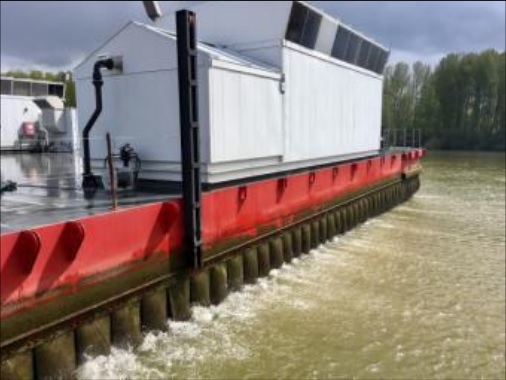 In April 2017, the hover barge was finally commissioned and christened by owners who performed machinery operational and lift mode tests and the barge is now ready-to-work. The massive barge was christened "Ghost" (photo lower left) because of its light "foot-print" of 1 psi (pounds per square inch) exerted on the surface of the ground while hovering about 5' off the surface. By comparison, a human footprint exerts 5 - 10 psi of ground pressure. As an example of the unit's light footprint, if areas with gullies have to be crossed, these can be filled on a temporary basis with 1m diameter x 2m long kit bags filled with plastic balls dropped in to form a seal and then removed as the barge passes over - leaving little evidence of the barge's passage.
In April 2017, the hover barge was finally commissioned and christened by owners who performed machinery operational and lift mode tests and the barge is now ready-to-work. The massive barge was christened "Ghost" (photo lower left) because of its light "foot-print" of 1 psi (pounds per square inch) exerted on the surface of the ground while hovering about 5' off the surface. By comparison, a human footprint exerts 5 - 10 psi of ground pressure. As an example of the unit's light footprint, if areas with gullies have to be crossed, these can be filled on a temporary basis with 1m diameter x 2m long kit bags filled with plastic balls dropped in to form a seal and then removed as the barge passes over - leaving little evidence of the barge's passage.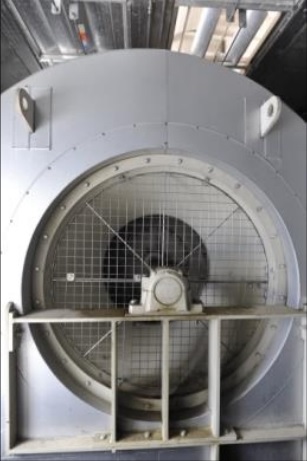 The hover barge also generates little underwater noise, as there is no contact between the pontoon and the water when on hover. The skirts, which are in the water, do not transmit sound well and all other sound is muffled by the air gap between both the barge itself and the internal air gap between the upper lower surfaces of the barge.
The hover barge also generates little underwater noise, as there is no contact between the pontoon and the water when on hover. The skirts, which are in the water, do not transmit sound well and all other sound is muffled by the air gap between both the barge itself and the internal air gap between the upper lower surfaces of the barge.
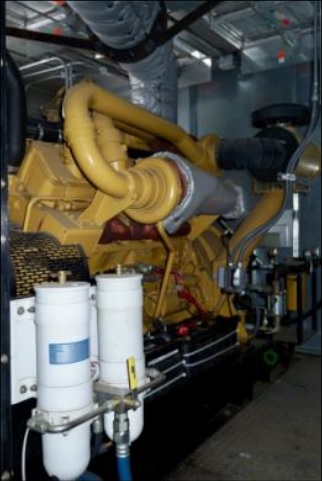 The 64.0m x 25.2m x 1.7m (210' x 82.7' x 5.6'), "Ghost" is capable of hauling up to 450 tonnes of containerized or odd dimension project cargoes & modules on a 55.2m x 16.2m (9,000 Sq. ft.) heavy deck over shallow water, ice, slush, swamps, wetlands, tundra and other environmentally challenging terrains where conventional vehicles & barges cannot work. The hull was built of DH-36 low temperature (-20 deg. F) steel and the unit is designed to operate in temperatures from +40 deg. C (104 deg. F) to - 20 deg. C. (-4 deg. F). Four 1,051HP CAT3412 engines drive Woodcock & Wilson lift fans abt. 5.5' in diameter in custom built, sound attenuated aluminum engine/fan houses, each fitted with CO2 fire suppression systems.
The 64.0m x 25.2m x 1.7m (210' x 82.7' x 5.6'), "Ghost" is capable of hauling up to 450 tonnes of containerized or odd dimension project cargoes & modules on a 55.2m x 16.2m (9,000 Sq. ft.) heavy deck over shallow water, ice, slush, swamps, wetlands, tundra and other environmentally challenging terrains where conventional vehicles & barges cannot work. The hull was built of DH-36 low temperature (-20 deg. F) steel and the unit is designed to operate in temperatures from +40 deg. C (104 deg. F) to - 20 deg. C. (-4 deg. F). Four 1,051HP CAT3412 engines drive Woodcock & Wilson lift fans abt. 5.5' in diameter in custom built, sound attenuated aluminum engine/fan houses, each fitted with CO2 fire suppression systems. 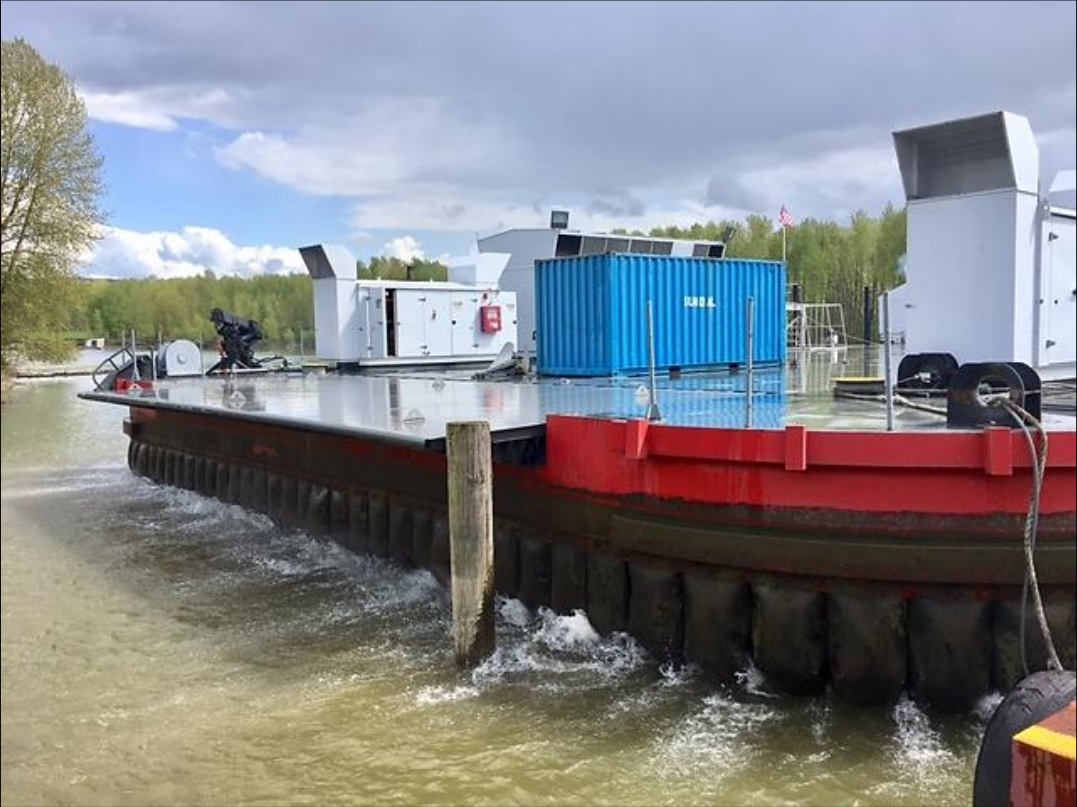 The barge has a 16' x 10' moon pool for coring & drilling operations, four 30 ton hydraulic deck winches, two knuckle boom cranes, two CAT diesel driven 3,000psi hydraulic power packs, one bow & two side Ro/Ro ramps with winches, an RF wireless remote control system and a 150kW Caterpillar generator. The barge is a good candidate to operate in environmentally sensitive habitats year-round hauling high-value cargoes, conducting geological surveys, coring and drilling via the moonpool, or performing other similar chores. The barge can be towed over shallow water, ice, swamps or land. When conditions allow, a shallow-draft tug or pushboat tug can be easily used. In the winter, or in other difficult conditions, the barge can be moved by tractors, amphibious vehicles such as an Amphitracs, Rolligons and hover craft or fitted with wheels or other methods of self-propulsion.
The barge has a 16' x 10' moon pool for coring & drilling operations, four 30 ton hydraulic deck winches, two knuckle boom cranes, two CAT diesel driven 3,000psi hydraulic power packs, one bow & two side Ro/Ro ramps with winches, an RF wireless remote control system and a 150kW Caterpillar generator. The barge is a good candidate to operate in environmentally sensitive habitats year-round hauling high-value cargoes, conducting geological surveys, coring and drilling via the moonpool, or performing other similar chores. The barge can be towed over shallow water, ice, swamps or land. When conditions allow, a shallow-draft tug or pushboat tug can be easily used. In the winter, or in other difficult conditions, the barge can be moved by tractors, amphibious vehicles such as an Amphitracs, Rolligons and hover craft or fitted with wheels or other methods of self-propulsion.
Now that the "Ghost" is fully operational and ready-to-work, Marcon International, Inc. of Coupeville, Washington has been appointed as exclusive broker by owners to once again market the "world's largest hover barge". Photographs, full technical description, videos, drawings & survey are available from this office to named, serious interests and can be downloaded from our website at www.marcon.com.
File MB20182 Hover Barge "Ghost"
"Ghost" Videos:
- 35 Years of Hoverbarge Operations
- Yukon Princess
Past Hover Barges:
